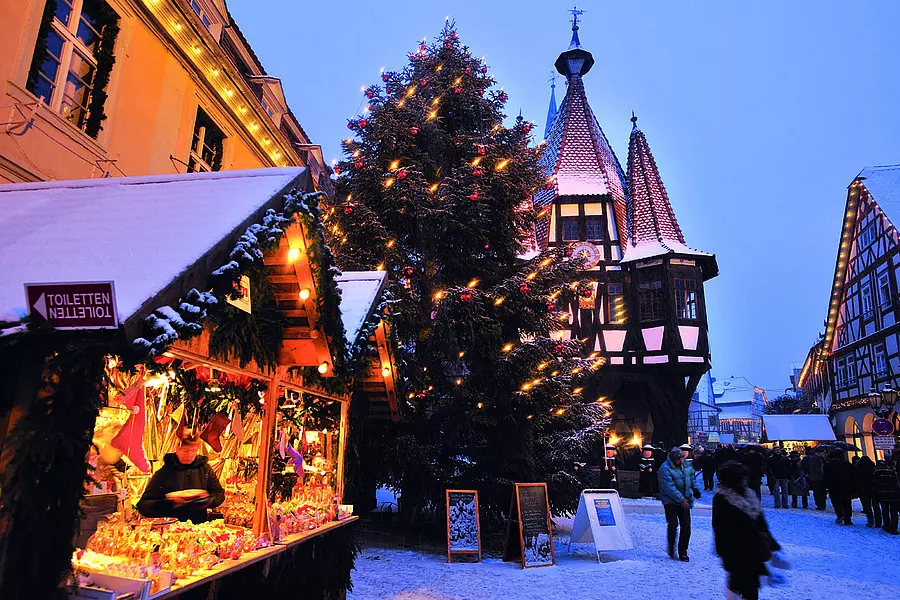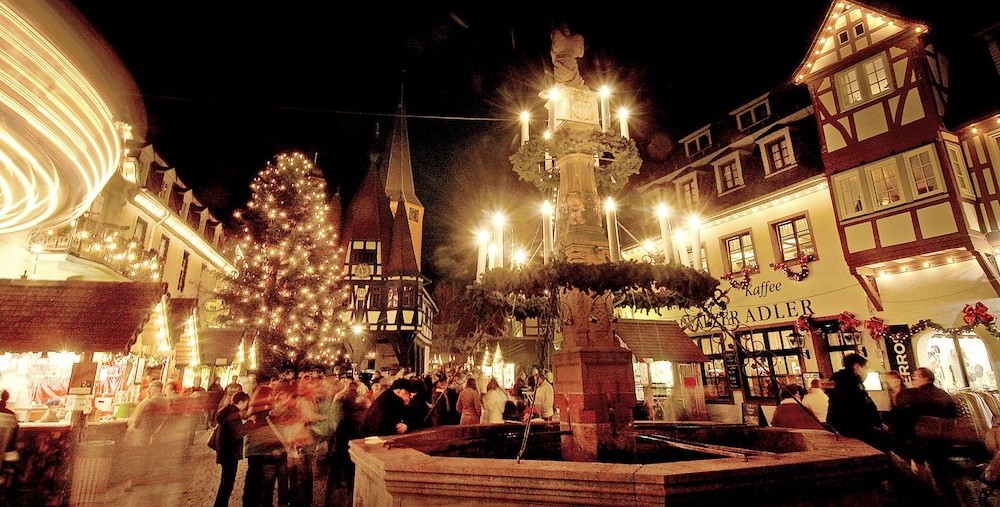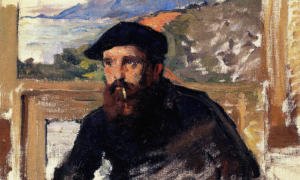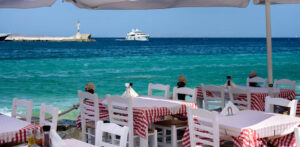(Editor’s note: This post on the Michelstadt Christmas Market is part of our series on lesser-known, but amazing, markets across Europe. You can see Metz here and Barcelona here.)
Did you know that holiday markets got their start in the German-speaking parts of Europe back in the Middle Ages? Interestingly, one of the most famous Germanic epic tales comes from the same era. Even better, I found for us a fabulous Christmas Market that’s located in the heart of where the famous story is said to be set.
It’s in the Odenwald, which includes about 60 square miles of territory southeast of Frankfurt.
Let me take you on a journey to Michelstadt and on the way, I will recount a bit of the folklore. We’ll follow the footsteps of the dragon-slaying prince, Siegfried. He’s the hero in a Medieval epic poem called “The Song of the Niebelung.” In German it’s called the Niebelungenlied (pronounced neeba-lung-in-leed).
Richard Wagner composed an opera for it. Instead of holiday tunes for our trip, let’s put on some mood music:
As Wagner swirls in our heads and underscores our anticipation, I’ll try not to swerve off the road. It’s hard to take my eyes off the jaw-dropping scenery. Just look at those bergs and bluffs crowned with castles and conifers.
A Christmas market like no other
This town has a long history and loads of old-world charm. But, first, let me fill you in on the holiday market: They serve farm-to-table hot-spiced apple wine at one of the stands. It isn’t just good, it’s himmlisch. In this town, the bragging rights for having the best quality is worth more than the price charged for the product.
There’s this guy who sells Holzschnitzereien (wood carvings) who is apprenticed from a long line of ancestors. You’ll see wood carvings all around this market. Back in the Middle Ages, the area was famous for sculpting ivory; nowadays, Michelstadt’s top-quality chiseled pieces steal the show. You’ll see life-sized carved sculptures that serve as directional signage through the labyrinth of quaint streets, an immense Christmas pyramid that spins on its axis with wooden figurines the size of toddlers and about 100 vender chalets decked in fir branches.

Ah, we have arrived in town.
I cut the car engine, the music stops and here we are. Covered in a dusting of winter snow, the town of Michelstadt. It feels like we stepped through a time warp to the year 1484. Have a walk under the gravity-defying timber-framed town hall. It stands on stilts guarding over the town square like a sentinel.
The building serves as a historical marker.
Michelstadt’s one of the oldest settlements in the inner Odenwald. A fiefdom in an almost-forgotten era tied to Charlemagne and the Frankish dynasty. Imagine that it has been here through all the centuries, year after year, with different folks celebrating Christmas in the same spot.
Although I can’t seem to find a knight in Medieval armor (where are you Siegfried?), I do find some pretty cool swords and carved handicrafts including neat wooden brushes, plumed feather dusters and wooden kitchen gadgets, juicers and pesto grinders.
And if you want to buy a ceramic Christmas village, check out the replicas of the historic town hall.
A history of epic drama
As you coil your way through the Medieval town, you won’t be able to keep that camera in your pocket. Michelstadt’s movie-set good looks are selfie-worthy. The best backdrops are the Rathaus, Thief’s Tower and Schloss Fürstenau. I imagine the mythical Brunhild in a setting like this. Although, by modern standards, her name doesn’t seem to indicate it, she was considered the queen of strength and beauty.
Her and Siegfried’s story is worse than Romeo and Juliet. At one point, they pretty much have the same options: Shall I kill my lover or myself, or both?
It probably didn’t all play out exactly on this spot, but it’s fun to imagine, anyway.
I suppose you figured out that although the Nibelungenlied is the finest of the many German heroic epics, it’s a bit of a downer since it ends in tragedy. I won’t spoil the plot (check the bottom of the story for a synopsis).
Unlike the poem, the people of Michelstadt are quite upbeat. They beam with pride when I show appreciation for their carefully crafted gift items. There’s a satisfying feeling in the holiday air. It’s not around the stuff we bought (although what we bought is super cool).
It’s more about the people. Perhaps it’s as Richard Wagner famously said: “Freude liegt nicht in den Dingen; es ist in uns“: “Joy is not in things; it is in us.”
Happy Holidays, and I hope you enjoyed our trip into the past as much as I did.
My two-minute summary
The Michestadt Market is open now through 23 December.
Here are maps and details of the market. You can download the program in .pdf form here.
Insider Intel:
You can find info on breweries here and here.
• Michelstadt isn’t far from the Bavarian border where one can sample styles of beers such as Michelstadter Dunkel or a Bavarian-style Weissbier.
•Wine enthusiasts can try Blaufrankish (a local Pinot Noir) or one of the excellent white wines from the slopes of the Odenwald foothills.
• Check out wines and quality dining
• Here’s info on apple wine
Michelstadt’s train line is direct to the town of Darmstadt (located just south of Frankfurt). It is a lovely ride and a romantic option to driving, although the drive is equally beautiful.
If you go by car, other not-to-miss sites just outside of town near Erbach:
• Palace of the Counts at Erbach-Fürstenau, a Frankish, early mediaeval castle complex.
• Jagdschloss Eulbach with Roman baths and Neckar-Odenwald-Limes Roman defensive frontier line.
• Erbach Christmas market – timber-framed houses, locally-made artistry and living nativity complete with donkeys and sheep.
• Wild game at the restaurant of the Zum Grünen Baum hotel.
Spoiler for JRR Tolkien fans: Scholars say he swiped elements of the Niebelungenlied (and many other ancient fables) for his book, “Lord of the Rings.” “The Niebelungenlied centers on the exploits of legendary and historical figures from the Age of Migrations. Of anonymous authorship, it was composed around the turn of the twelfth to the thirteenth century and remained enormously popular to the end of the Middle Ages. Like most other medieval literature, however, it sank into oblivion in the 16th century.”
The WHOLE story (for those who want to be in the know): Here’s a two-minute whirl-wind video summary of the Niebelungenlied.
–––––––––––
See more on Christmas Markets here in Dispatches’ archives.
Alice Verberne is a contributing writer for Dispatches Europe. She has worked in print journalism and magazine production in the United States and Europe throughout her career. She currently resides in France where she enjoys visiting former French speaking colonies and discussing history with the locals.















